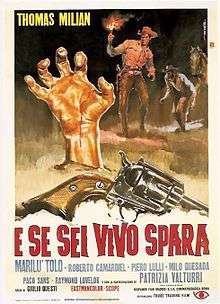Django Kill... If You Live, Shoot!
| Django Kill... If You Live, Shoot! (Se sei vivo spara) | |
|---|---|
 Italian film poster | |
| Directed by | Giulio Questi |
| Produced by | Alessandro Jacovoni |
| Screenplay by |
Franco Arcalli Giulio Questi Benedetto Benedetti |
| Story by | María del Carmem Martínez Román |
| Starring |
Tomas Milian Marilù Tolo Roberto Camardiel Piero Lulli Milo Quesada Paco Sanz Raymond Lovelock Patrizia Valturri |
| Music by | Ivan Vandor |
| Cinematography | Franco Delli Colli |
| Edited by | Franco Arcalli |
Production company |
GIA Società Cinematografica Hispamer Films |
| Distributed by |
Trose Trading Film Titanus Distribuzione[1] |
Release dates | 3 May 1967 |
Running time | 117 minutes |
| Country |
Italy Spain |
| Language | Italian |
Django Kill... If You Live, Shoot! (Italian: Se sei vivo spara, lit. If You Live Shoot), also known as Oro Hondo and simply as Django Kill!, is a 1967 Italian Spaghetti Western horror film directed and co-written by Giulio Questi.[2]
Despite the fact that it has "Django" in its title (outside of Italy), the movie has nothing to do with the Django movies.[3] It is well known for the surrealistic violence and for the psychedelic editing of Franco "Kim" Arcalli. Phil Hardy defines it as "the most brutally violent spaghetti western ever made".[4] Describing the film, Christopher Frayling says that "the violence was of an extraordinarily savage kind".[5] Antonio Bruschini writes that "this film is the first western to offer a sample of truly horrendous scenes".[6] Marco Giusti defines the film as the most violent and bizarre ever filmed in Italy.[7]
One week after its release, an Italian Court confiscated Django Kill for its scabrous violence. The film was re-released seven days later, with 22 minutes removed.[8] The film had censor problems in many other countries: in the United Kingdom, the BBFC removed about half an hour of film.[9] Recently, several DVD editions restored the removed scenes, publishing the film in an uncut and uncensored version.[8]
Plot
American and Mexican outlaws rob a US Army gold transport. After the successful ambush the Americans attempt to keep the booty for themselves by planning to execute the Mexicans, though one of their number breaks free and kills several of their horses with a machete. The Mexicans dig their own grave and are shot, however their leader is badly wounded and survives being buried alive. He is rescued by a pair of Indians who treat his wounds in exchange for his addressing their people on what he has seen of the afterlife during the period he was "dead". They also give him golden bullets to use for his revenge. Pursuing the gang that killed his comrades, the Stranger finds shelter among locals but Templer, a saloon owner, Hagerman an Alderman who keeps his wife a prisoner in their home and Sorrow, the leader of a band of black garbed homosexuals hear about the gold and want it for themselves.
Cast
- Tomas Milian as The Stranger
- Marilù Tolo as Flory
- Roberto Camardiel as Sorrow
- Paco Sanz as Alderman
- Milo Quesada as Bill Templer
- Piero Lulli as Oaks
- Ray Lovelock as Evan Templer
- Patrizia Valturri as Elizabeth Alderman
- Miguel Serrano as Indian
- Ángel Silva as Indian
- Félix Sancho Gracia as Willy
- Mirella Pamphili as Townswoman
- Lars Bloch as Oaks Henchman (uncredited)
- Frank Braña as Townsman (uncredited)
- Gene Collins as Collins (uncredited)
- Rafael Hernández as Richie (uncredited)
- Herman Reynoso as Townsman (uncredited)
References
- ↑ "Se sei vivo spara (1967)". Archivio del Cinema Italiano On-Line.
- ↑ Cox, Alex (2009). 10,000 Ways to Die: A Director's Take on the Spaghetti Western. Oldcastle Books. ISBN 978-1-84243-304-1.
- ↑ Rob Wilson,Christopher Leigh Connery. The worlding project: doing cultural studies in the era of globalization. North Atlantic Books, 2007.
- ↑ Phil Hardy. The Film Encyclopedia: The Western. William Morrow, 1983. p. 302.
- ↑ Christopher Frayling. Spaghetti westerns: cowboys and Europeans from Karl May to Sergio Leone. I.B.Tauris, 2006. p. 82. ISBN 1-84511-207-5.
- ↑ Antonio Bruschini. Western all'italiana: The specialists. Glittering images, 1998. p. 55. ISBN 88-8275-034-5.
- ↑ Marco Giusti. Dizionario del western all'italiana. Mondadori, 2007. p. 381. ISBN 88-04-57277-9.
- 1 2 Howard Hughes. Once upon a time in the Italian West. I.B. Tauris, 2004. ISBN 1-85043-430-1.
- ↑ Simon Banner (August 1987). "Hell on Reels". SPIN. 3 (5).